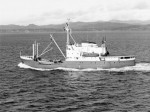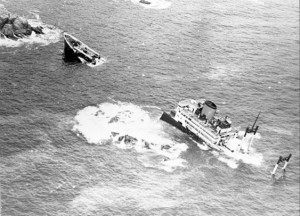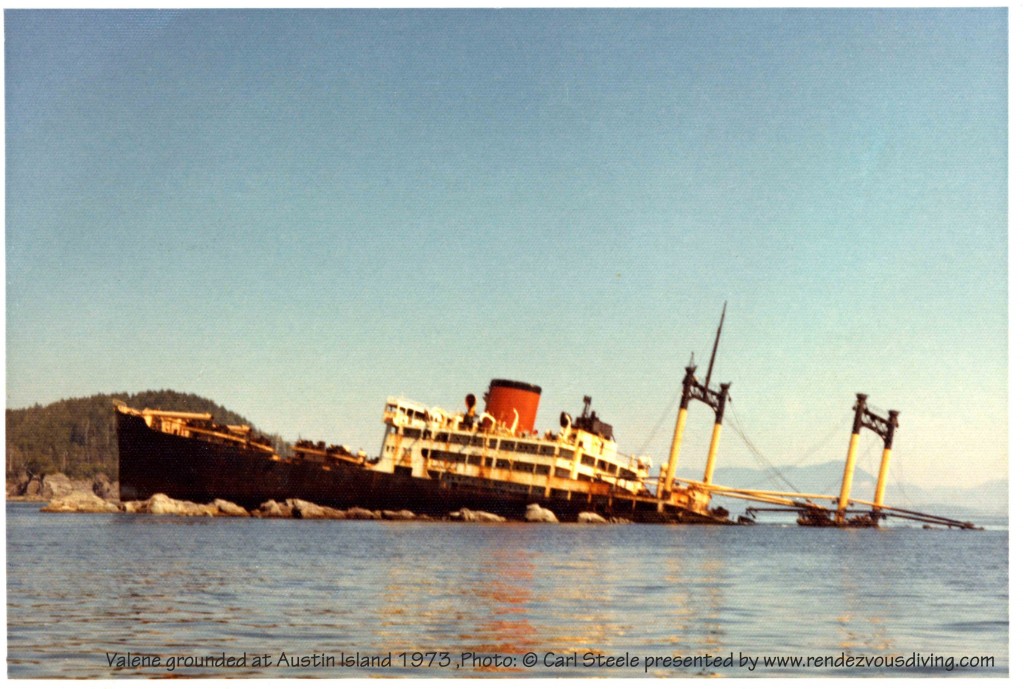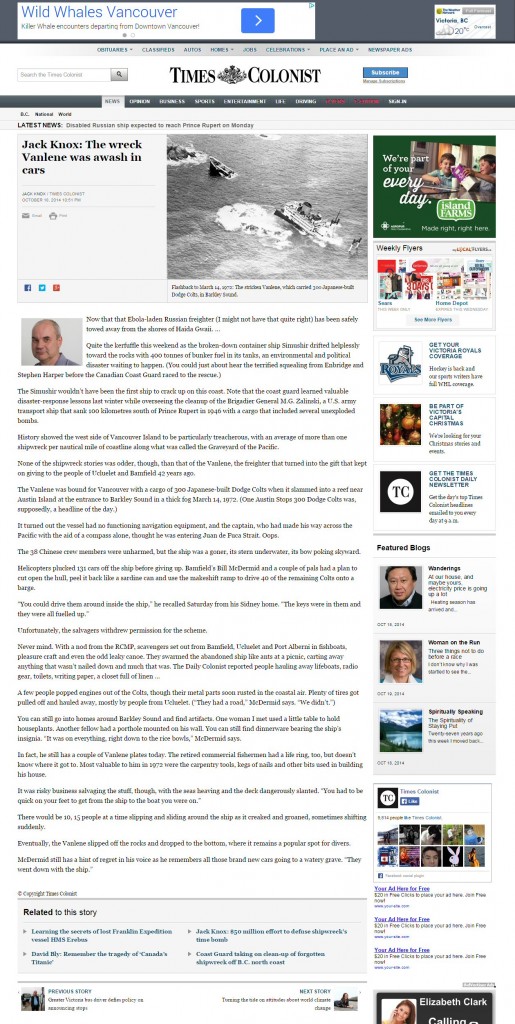I received the following email the other day promoting an article on a friend’s website:
The freighter Vanlene ran up on the rocks on Austin Island in the Broken Group islands on March 14, 1972. She was carrying 300 Dodge Colt automobiles while enroute to Vancouver BC from Japan. The crew was rescued and taken to Port Alberni. How she ended up on the rocks is still a matter of conjecture but it appears that the Master simply did not know where he was at the time of impact (he thought he was off of the coast of Washington) and his navigational aids were inoperable. See the article at Nauticapedia.

The name Vanlene brought all kinds of memories rushing into my mind.
I, with my family, pets and foster child were pounding our way up the outer coast of Vancouver Island sometime in August 1972, only a few months after the Vanlene sinking. We were travelling on the Canadian Coast Guard Ship Camsell. We were on our way to a new lighthouse on Kains Island (Quatsino) after being picked up at Pulteney Point lighthouse the week before.
The Coast Guard seems to always travel clockwise around Vancouver Island (no idea why) and so we left Pulteney, headed down the inside waters between Vancouver Island and mainland BC. We then stopped at the Coast Guard base in Victoria, and then headed up the outside. Nice trip for us (more on that in another story).

The Camsell is an ice breaker. “So what!” you might say. “You try it!” I might say. An icebreaker is made to rock and roll to enable it to break ice. When there is no ice it still tends to rock and roll! The outside of Vancouver Island (open Pacific in other words) is never calm. There is always a swell, This also makes a boat want to rock and roll, but if the Captain is good, usually only in one direction. An ice breaker rocks from side to side and front to back all at the same time, or so it seems.
I loved it! My wife Karen and the small boy also had no problems. The dog and cats managed, although the cats looked kinda drunk! Their eyes were rolled up into their heads from the tranquillizers. We ate hearty meals and loved the sunshine.
Back to the Vanlene, one of officers pointed out the location as we steamed past. We had heard about the wreck in the newspapers. From what I heard, some cars were salvaged by locals after others had given up.
Researching this story I came across many websites with articles on the Vanlene (see below). A few sunken cars are not too much of a hazard. The Vanlene was leaking oil for weeks afterwards. Now they want to send Chinese oil tankers full of tar-sands crude oil down our coast.
Only after the Last Tree has been cut down,
Only after the Last River has been poisoned,
Only after the Last Fish has been caught,
Only then will you find that Money Cannot be Eaten.Cree Prophecy
*****************************
Vanlene story links, besides the one mentioned at the beginning:
Newsvine.com – diving on the site
Nauticapedia – The Wreck of the Freighter Vanlene
Jack Knox: The wreck Vanlene was awash in cars
JACK KNOX / TIMES COLONIST
OCTOBER 18, 2014 10:51 PM

Flashback to March 14, 1972: The stricken Vanlene, which carried 300 Japanese-built Dodge Colts, in Barkley Sound.
Quite the kerfuffle this weekend as the broken-down container ship Simushir drifted helplessly toward the rocks with 400 tonnes of bunker fuel in its tanks, an environmental and political disaster waiting to happen. (You could just about hear the terrified squealing from Enbridge and Stephen Harper before the Canadian Coast Guard raced to the rescue.)
The Simushir wouldn’t have been the first ship to crack up on this coast. Note that the coast guard learned valuable disaster-response lessons last winter while overseeing the cleanup of the Brigadier General M.G. Zalinski, a U.S. army transport ship that sank 100 kilometres south of Prince Rupert in 1946 with a cargo that included several unexploded bombs.
History showed the west side of Vancouver Island to be particularly treacherous, with an average of more than one shipwreck per nautical mile of coastline along what was called the Graveyard of the Pacific.
None of the shipwreck stories was odder, though, than that of the Vanlene, the freighter that turned into the gift that kept on giving to the people of Ucluelet and Bamfield 42 years ago.
The Vanlene was bound for Vancouver with a cargo of 300 Japanese-built Dodge Colts when it slammed into a reef near Austin Island at the entrance to Barkley Sound in a thick fog March 14, 1972. (One Austin Stops 300 Dodge Colts was, supposedly, a headline of the day.)
It turned out the vessel had no functioning navigation equipment, and the captain, who had made his way across the Pacific with the aid of a compass alone, thought he was entering Juan de Fuca Strait. Oops.
The 38 Chinese crew members were unharmed, but the ship was a goner, its stern underwater, its bow poking skyward.
Helicopters plucked 131 cars off the ship before giving up. Bamfield’s Bill McDermid and a couple of pals had a plan to cut open the hull, peel it back like a sardine can and use the makeshift ramp to drive 40 of the remaining Colts onto a barge.
“You could drive them around inside the ship,” he recalled Saturday from his Sidney home. “The keys were in them and they were all fuelled up.”
Unfortunately, the salvagers withdrew permission for the scheme.
Never mind. With a nod from the RCMP, scavengers set out from Bamfield, Ucluelet and Port Alberni in fishboats, pleasure craft and even the odd leaky canoe. They swarmed the abandoned ship like ants at a picnic, carting away anything that wasn’t nailed down and much that was. The Daily Colonist reported people hauling away lifeboats, radio gear, toilets, writing paper, a closet full of linen …
A few people popped engines out of the Colts, though their metal parts soon rusted in the coastal air. Plenty of tires got pulled off and hauled away, mostly by people from Ucluelet. (“They had a road,” McDermid says. “We didn’t.”)
You can still go into homes around Barkley Sound and find artifacts. One woman I met used a little table to hold houseplants. Another fellow had a porthole mounted on his wall. You can still find dinnerware bearing the ship’s insignia. “It was on everything, right down to the rice bowls,” McDermid says.
In fact, he still has a couple of Vanlene plates today. The retired commercial fishermen had a life ring, too, but doesn’t know where it got to. Most valuable to him in 1972 were the carpentry tools, kegs of nails and other bits used in building his house.
It was risky business salvaging the stuff, though, with the seas heaving and the deck dangerously slanted. “You had to be quick on your feet to get from the ship to the boat you were on.”
There would be 10, 15 people at a time slipping and sliding around the ship as it creaked and groaned, sometimes shifting suddenly.
Eventually, the Vanlene slipped off the rocks and dropped to the bottom, where it remains a popular spot for divers.
McDermid still has a hint of regret in his voice as he remembers all those brand new cars going to a watery grave. “They went down with the ship.”

